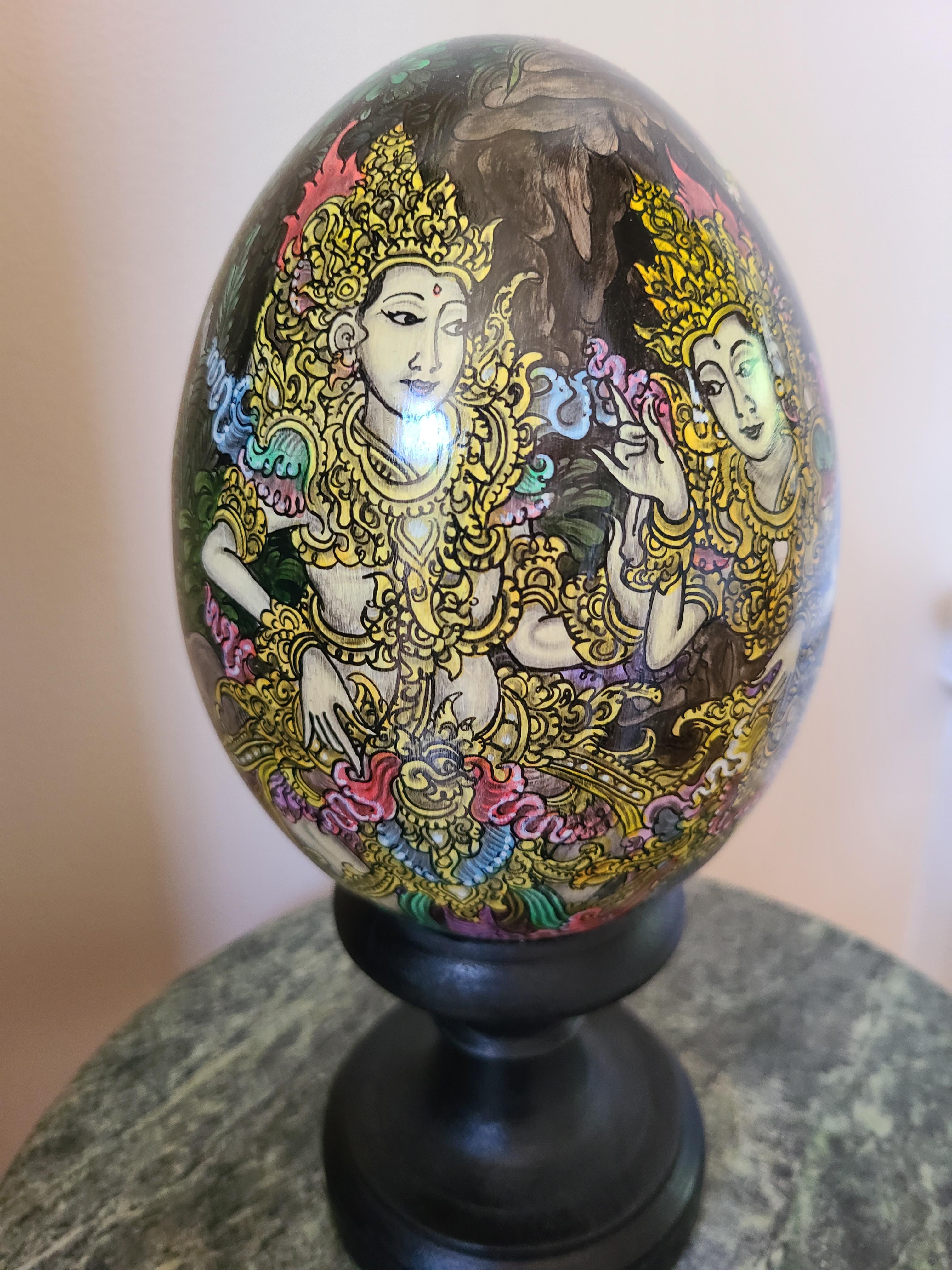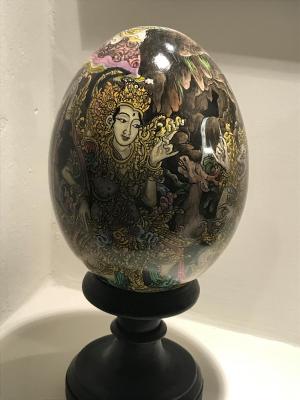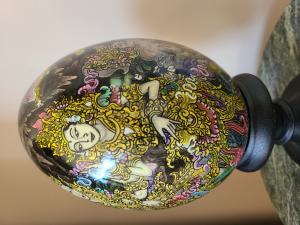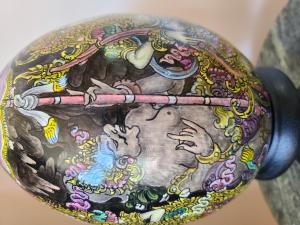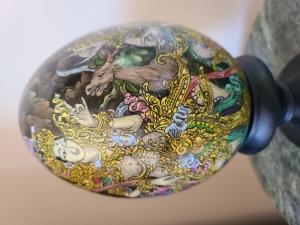Javanese painted wooden Ramayana egg
Unknown
Craft
Hand-crafted painted colorful wooden egg crafted in Java from Albesia wood, with the figures from an ancient Indian epic Ramayana: Sita, Surpanakha, Rahwana, and Maricha in the form of a deer, on the wooden stand.
Egg painting is one of the many traditional crafts still practiced in Indonesia. This egg is less colorful than the other egg in the collection, item number 100.
Aug 7 2016 Ubud St. Bali
Egg painting is one of the many traditional crafts still practiced in Indonesia. This egg is less colorful than the other egg in the collection, item number 100.
Aug 7 2016 Ubud St. Bali
Egg painting is an incredibly delicate and specialized art form requiring exquisite patience and skill, built over years of experience. Archaeologists have long known of decorated ostrich shell pieces and empty eggs in Africa of great antiquity, found in tombs or archaeological digs. From ancient history to the present eggs have been an important symbol in many cultures. They are part of the creation myths of many peoples, the “cosmic egg” from which all or parts of the universe arises. They often symbolize life, renewal, and rebirth.
Major characters from Ramayana, an ancient Indian epic, are painted on this egg: Sita, the central female character, the consort of the god Rama; demon Maricha (or Mareecha) in the figure of a deer, an ally of Ravana and the antagonist of the epic, whose most notable exploit is his role in the kidnapping of Sita; Rahwana (also known as Ravana), the demon king of Lanka, the island fortress capital, who abducts Sita appearing as a mendicant (Sadhu); and Surpanakha (or Shurpanakha), the sister of demon Rahwana who fell in love with Rama and had the magical power to take any form she wanted.
Ramayana is a shorter of the two great epic poems of India, the other being the Mahabharata. The Ramayana was composed in Sanskrit, probably not before 300 BCE, by the poet Valmiki and in its present form consists of some 24,000 couplets divided into seven books. Ramayana characters are popular throughout Indonesian art and Asian art in general.
This eggs depicts the story from Ramayana where Sita is being deceived by the demon Maricha in the figure of a deer in order to kidnap her.
One day, Surpanakha, the rakshasa sister of Ravana, disguised herself as a beautiful maiden and proposed marriage to Rama. Rama refused her proposal and directed her to Lakshmana, his brother, in jest. Lakshmana joked that she should marry his master Rama. An angry Surpanakha returned to Rama and attacked Sita. But Lakshmana took out his sword and cut off Shurpanakha's ears and nose. The humiliated Surpanakha approached Khara, a man-eating demon, to avenge her with a vendetta against Rama. However, Khara and his army were killed by Rama when they attacked him. Surpanakha and her maternal uncle, Akampana, who escaped the carnage, proposed that Rahwana steal Sita, Rama's beautiful wife.
Rahwana flew in his aerial chariot across the sea to meet his ally, Maricha. Maricha lived in a secluded hermitage on the ocean coast. Rahwana told Maricha to turn into a golden deer with silver spots and graze in the vicinity of Rama's ashram. On seeing the deer, Sita would surely tell Rama and Lakshamana to catch it. When the brothers left Sita alone, Rahwana would abduct her. Rama, saddened by the grief of Sita's separation, would be easily killed by Ravana. The wise Maricha attempted to dissuade Rahwana.
However, Rahwana ignored Maricha's words. Rahwana announced that he would abduct Sita with or without Maricha's help to get revenge for the death of rakshasas. He reiterated his plan and told Maricha to be the golden deer. If successful, he and Maricha would return to Lanka and Rahwana would grant half his kingdom to Maricha. Finally Maricha agreed. Maricha and Rahwana then flew to Panchavati in Ravana’s chariot and stopped close to the ashram of Rama. Maricha then assumed the form of a beautiful golden deer, which had silver spots and glowed with many gems like sapphire, moonstone, black jet and amethyst on its body. Maricha began grazing in the vicinity of Rama's ashram so that Sita would catch a glimpse of him. As soon as the animal-eating rakshasa Maricha entered the forest in the form of a deer, the other animals smelt something was wrong and ran away in fear. Maricha found Sita collecting flowers and ran in front of her. The golden luster of the deer which was gamboling around the hermitage lured Sita, who was awestruck and called Rama and Lakshmana to see the spectacular animal.
On seeing the wondrous deer, Lakshmana sensed foul play and suggested that the deer was an illusory form of Maricha, who preyed on kings who came into the forest for hunting. Sita persuaded Rama to get her the deer, dead or alive. Rama said that this deer would die at his hands that day to comply with Sita's wish, or, if it was a magical rakshasa like Maricha – who killed kings and harmed sages – as Lakshmana had said, then too it was his duty to kill the beast. Rama decided to go after the deer and slay it and asked Lakshmana to take care of Sita in the meantime.
Maricha ran, followed by Rama. Maricha led Rama far away from the hermitage, which made Rama very angry. After a long chase, the tired deer stopped in a shady grassland. Rama seized the opportunity and shot it down with his golden arrow. Sita fell prey to the ruse and asked Lakshmana to go and search for Rama. When Lakshmana insisted that no one could harm Rama, Sita – still very much worried – implored, and then ordered Lakshmana to go. Lakshmana reluctantly left to look for Rama. With Lakshmana gone, Rahwana appeared as a mendicant (Sadhu) and kidnapped Sita as she stepped forward to give him alms. The Ramayana then narrates the tale of how Rama defeats Rahwana in Lanka and regains Sita.
The story of Ramayana is spread in various forms throughout Southeast Asia (especially in Indonesia, Cambodia, and Thailand), and its heroes, together with the Pandava brothers of the Mahabharata, are also the heroes of traditional Javanese-Balinese theatre, dance, and shadow plays. Incidents from the Ramayana are depicted throughout Indonesian Art.
Major characters from Ramayana, an ancient Indian epic, are painted on this egg: Sita, the central female character, the consort of the god Rama; demon Maricha (or Mareecha) in the figure of a deer, an ally of Ravana and the antagonist of the epic, whose most notable exploit is his role in the kidnapping of Sita; Rahwana (also known as Ravana), the demon king of Lanka, the island fortress capital, who abducts Sita appearing as a mendicant (Sadhu); and Surpanakha (or Shurpanakha), the sister of demon Rahwana who fell in love with Rama and had the magical power to take any form she wanted.
Ramayana is a shorter of the two great epic poems of India, the other being the Mahabharata. The Ramayana was composed in Sanskrit, probably not before 300 BCE, by the poet Valmiki and in its present form consists of some 24,000 couplets divided into seven books. Ramayana characters are popular throughout Indonesian art and Asian art in general.
This eggs depicts the story from Ramayana where Sita is being deceived by the demon Maricha in the figure of a deer in order to kidnap her.
One day, Surpanakha, the rakshasa sister of Ravana, disguised herself as a beautiful maiden and proposed marriage to Rama. Rama refused her proposal and directed her to Lakshmana, his brother, in jest. Lakshmana joked that she should marry his master Rama. An angry Surpanakha returned to Rama and attacked Sita. But Lakshmana took out his sword and cut off Shurpanakha's ears and nose. The humiliated Surpanakha approached Khara, a man-eating demon, to avenge her with a vendetta against Rama. However, Khara and his army were killed by Rama when they attacked him. Surpanakha and her maternal uncle, Akampana, who escaped the carnage, proposed that Rahwana steal Sita, Rama's beautiful wife.
Rahwana flew in his aerial chariot across the sea to meet his ally, Maricha. Maricha lived in a secluded hermitage on the ocean coast. Rahwana told Maricha to turn into a golden deer with silver spots and graze in the vicinity of Rama's ashram. On seeing the deer, Sita would surely tell Rama and Lakshamana to catch it. When the brothers left Sita alone, Rahwana would abduct her. Rama, saddened by the grief of Sita's separation, would be easily killed by Ravana. The wise Maricha attempted to dissuade Rahwana.
However, Rahwana ignored Maricha's words. Rahwana announced that he would abduct Sita with or without Maricha's help to get revenge for the death of rakshasas. He reiterated his plan and told Maricha to be the golden deer. If successful, he and Maricha would return to Lanka and Rahwana would grant half his kingdom to Maricha. Finally Maricha agreed. Maricha and Rahwana then flew to Panchavati in Ravana’s chariot and stopped close to the ashram of Rama. Maricha then assumed the form of a beautiful golden deer, which had silver spots and glowed with many gems like sapphire, moonstone, black jet and amethyst on its body. Maricha began grazing in the vicinity of Rama's ashram so that Sita would catch a glimpse of him. As soon as the animal-eating rakshasa Maricha entered the forest in the form of a deer, the other animals smelt something was wrong and ran away in fear. Maricha found Sita collecting flowers and ran in front of her. The golden luster of the deer which was gamboling around the hermitage lured Sita, who was awestruck and called Rama and Lakshmana to see the spectacular animal.
On seeing the wondrous deer, Lakshmana sensed foul play and suggested that the deer was an illusory form of Maricha, who preyed on kings who came into the forest for hunting. Sita persuaded Rama to get her the deer, dead or alive. Rama said that this deer would die at his hands that day to comply with Sita's wish, or, if it was a magical rakshasa like Maricha – who killed kings and harmed sages – as Lakshmana had said, then too it was his duty to kill the beast. Rama decided to go after the deer and slay it and asked Lakshmana to take care of Sita in the meantime.
Maricha ran, followed by Rama. Maricha led Rama far away from the hermitage, which made Rama very angry. After a long chase, the tired deer stopped in a shady grassland. Rama seized the opportunity and shot it down with his golden arrow. Sita fell prey to the ruse and asked Lakshmana to go and search for Rama. When Lakshmana insisted that no one could harm Rama, Sita – still very much worried – implored, and then ordered Lakshmana to go. Lakshmana reluctantly left to look for Rama. With Lakshmana gone, Rahwana appeared as a mendicant (Sadhu) and kidnapped Sita as she stepped forward to give him alms. The Ramayana then narrates the tale of how Rama defeats Rahwana in Lanka and regains Sita.
The story of Ramayana is spread in various forms throughout Southeast Asia (especially in Indonesia, Cambodia, and Thailand), and its heroes, together with the Pandava brothers of the Mahabharata, are also the heroes of traditional Javanese-Balinese theatre, dance, and shadow plays. Incidents from the Ramayana are depicted throughout Indonesian Art.
Height: 10”
Width: 5”
Depth: 5”
inches
Heritage Hotel, Solo, Java Indonesia
Solo, Java, Indonesia
Materials: Albesia wood (Albizia Falcata, also known as Belalu wood, white soft wood), acrylic paint, varnish.
Technique: painted wooden egg.
When real eggs are painted, they are pricked and drained through a tiny hole in the bottom and then cleaned.
When wooden eggs are painted, the wood is carved in the shape of an egg.
Then the surface is cleaned, polished, and prepared for painting. When the surface is prepared for painting, the design is sketched on the egg, and then the eggshell or the wooden surface is painted with acrylic paints.
When painting is finished, the eggs are dried and varnished to protect the paint and preserve the brightness of colors. When this process is completed, the egg is placed on the stand, usually made out of wood.
Unknown
